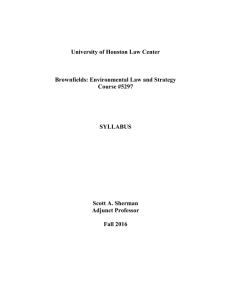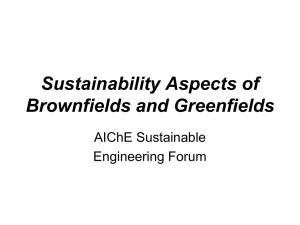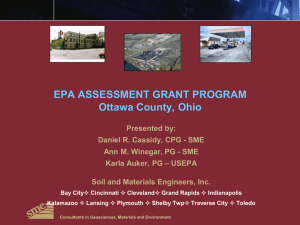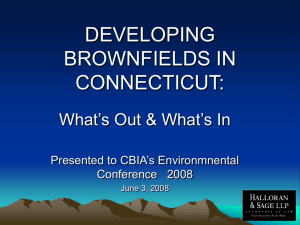Brownfields Policy Reform in Wisconsin: A New Regulatory Culture
advertisement
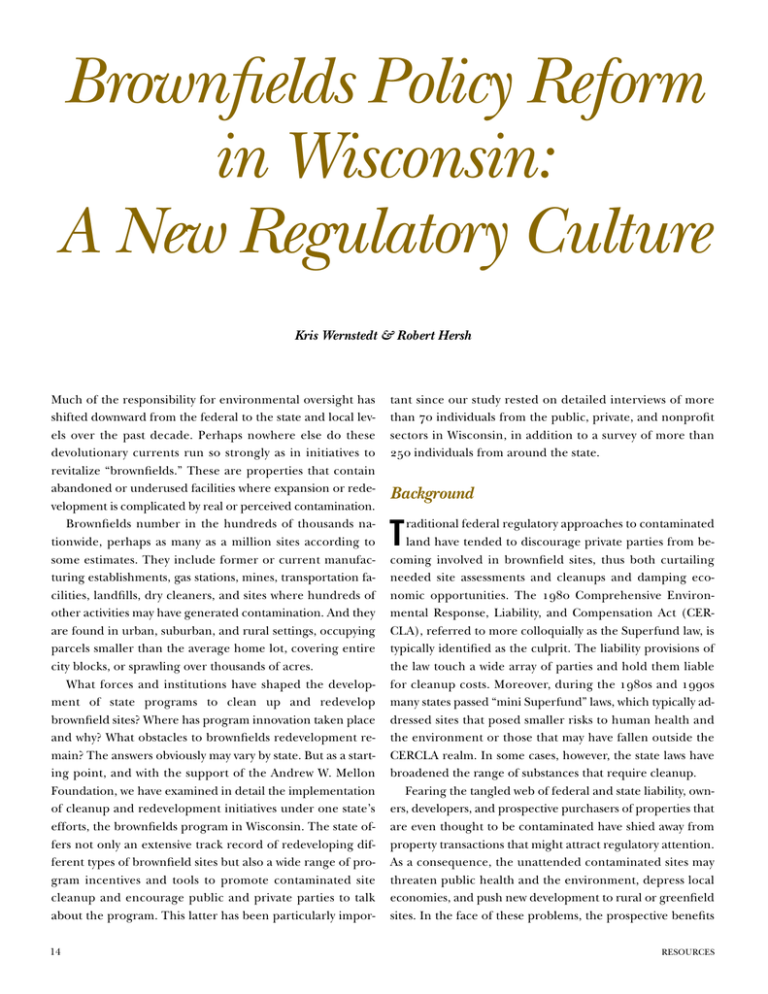
Brownfields Policy Reform in Wisconsin: A New Regulatory Culture Kris Wernstedt & Robert Hersh Much of the responsibility for environmental oversight has shifted downward from the federal to the state and local levels over the past decade. Perhaps nowhere else do these devolutionary currents run so strongly as in initiatives to revitalize “brownfields.” These are properties that contain abandoned or underused facilities where expansion or redevelopment is complicated by real or perceived contamination. Brownfields number in the hundreds of thousands nationwide, perhaps as many as a million sites according to some estimates. They include former or current manufacturing establishments, gas stations, mines, transportation facilities, landfills, dry cleaners, and sites where hundreds of other activities may have generated contamination. And they are found in urban, suburban, and rural settings, occupying parcels smaller than the average home lot, covering entire city blocks, or sprawling over thousands of acres. What forces and institutions have shaped the development of state programs to clean up and redevelop brownfield sites? Where has program innovation taken place and why? What obstacles to brownfields redevelopment remain? The answers obviously may vary by state. But as a starting point, and with the support of the Andrew W. Mellon Foundation, we have examined in detail the implementation of cleanup and redevelopment initiatives under one state’s efforts, the brownfields program in Wisconsin. The state offers not only an extensive track record of redeveloping different types of brownfield sites but also a wide range of program incentives and tools to promote contaminated site cleanup and encourage public and private parties to talk about the program. This latter has been particularly impor14 tant since our study rested on detailed interviews of more than 70 individuals from the public, private, and nonprofit sectors in Wisconsin, in addition to a survey of more than 250 individuals from around the state. Background raditional federal regulatory approaches to contaminated land have tended to discourage private parties from becoming involved in brownfield sites, thus both curtailing needed site assessments and cleanups and damping economic opportunities. The 1980 Comprehensive Environmental Response, Liability, and Compensation Act (CERCLA), referred to more colloquially as the Superfund law, is typically identified as the culprit. The liability provisions of the law touch a wide array of parties and hold them liable for cleanup costs. Moreover, during the 1980s and 1990s many states passed “mini Superfund” laws, which typically addressed sites that posed smaller risks to human health and the environment or those that may have fallen outside the CERCLA realm. In some cases, however, the state laws have broadened the range of substances that require cleanup. Fearing the tangled web of federal and state liability, owners, developers, and prospective purchasers of properties that are even thought to be contaminated have shied away from property transactions that might attract regulatory attention. As a consequence, the unattended contaminated sites may threaten public health and the environment, depress local economies, and push new development to rural or greenfield sites. In the face of these problems, the prospective benefits T RESOURCES for communities of revitalizing contaminated and underutilized properties are significant. For example, the nearly 100 local planners and economic development officials in Wisconsin included in our survey clearly support such revitalization. More than three-quarters of these respondents indicated that traditional economic development objectives of infrastructure use, tax revenues, and job creation were “important” to “very important” reasons to redevelop contaminated properties. Other benefits — such as reducing environmental and public health risks, and removing eyesores—also attracted a high percentage of respondents. With such potential benefits why do so many brownfield sites in Wisconsin and elsewhere remain underutilized? Clearly some properties may be undesirable regardless of contamination, simply because of poor real-estate fundamentals. They may offer insufficient acreage to host some types of activities, suffer from inadequate transportation connections, lie in poor locations with respect to potential customers, lack ready access to a skilled labor pool, face opaque or onerous local permitting processes, or simply lie in a depressed regional real estate market. If contaminated, the cost of cleanup may actually exceed the market value of the property. The liability provisions of CERCLA and state laws can sharpen these disadvantages to the extent that they impose uncertain liabilities for cleanup on parties that may not have contributed to the contamination in the first place. Municipalities, in particular, may be caught in a bind. Abandoned and contaminated properties may appear ripe for tax foreclosure and redevelopment, but the risk of taking ownership and being stuck for cleanup and possible legal claims by adjacent landowners and other parties may outweigh potential gains. Brownfields Reform any different interests have tried to reform CERCLA and its state equivalents almost since the inception of the statutes. The main thrust for these reform efforts has been to reduce liability burdens and to provide incentives that could encourage more risk taking in the real estate market by public and private sector entrepreneurs. At the federal level, these pressures ultimately resulted in the 2002 Small Business Liability Relief and Brownfields Revitalization Act, which provides conditional liability relief to some parties involved in brownfield properties, as well as up to $200 million annually for site assessment and cleanup grants, and up to $50 million annually for support of state response programs. Well before Congress’s action, many states had moved off the mark in the 1990s and passed legislation to curtail the reach of their own liability provisions. Their actions typically M SPRING 2004 have scaled back environmental requirements by tailoring cleanup requirements to the expected future use of the properties rather than requiring, for example, the same cleanup at a parcel whether it is slated for development as an industrial park or as a playground. Many also provided some form of liability release upon state approval of cleanup and offered incentives to spur private interest. All but a handful have developed formal voluntary cleanup or brownfield programs that operate in a less burdensome and more voluntary fashion to proactively encourage redevelopment. In Wisconsin, many of these reforms were embodied in the 1994 Land Recycling Act. This law exempted many parties from cleanup liability under certain circumstances and created incentives for municipalities and private parties to acquire, clean up, and redevelop contaminated real estate. Under the law, a municipality could become exempt from cleanup obligations if it acquired contaminated property through tax-delinquency proceedings or as a result of an order by a bankruptcy court, didn’t exacerbate the problem, and met several requirements related to site access and investigations. Lenders received a similar exemption if they took title to a contaminated property through enforcement of a security interest in the property. Purchasers of contaminated sites, in perhaps the most farreaching aspects of the legislation, could receive exemptions for future liability by following a prescribed process laid out in a set of administrative rules from the state’s Department of Natural Resources (DNR). Subsequent changes to the law through the state’s biennial budget bills of 1997, 1999, and 2001 broadened eligibility for liability relief to include even culpable parties and made it possible for owners to receive a certificate of completion from DNR stating that no additional action would be required at the site even if the remedy fails or standards change. At the same time that detailed cleanup requirements were developed to encourage interest in brownfield sites, a DNR advisory group that began to meet in 1995 suggested that the department embrace the concept of remediating contaminated lands for beneficial reuse and that it partner with an array of brownfield reuse interests. Its recommendations, though rather diffidently stated, called for a profound change in the way DNR staff would have to work with the private sector to return sites back to productive use. Not only would the timing of a cleanup decision have to be made to help facilitate real estate transactions, but also DNR officials were expected to consider the welfare of the community in which the site was located. Several years later, the state legislature directed the DNR to form a brownfields study group to evaluate the state’s 15 brownfield initiatives. This group — comprised of lawyers, local mayors and economic development officials, planners, representatives of community-based organizations, and others — has become the most important source of ideas and innovation in state brownfields policy. It has recommended scores of programmatic innovations that have been put into effect, including the provision of state funds for site assessments, cleanup, and redevelopment; new local financing mechanisms to encourage brownfields development; liability relief for municipalities and private parties; and reforms that allow cleanups that rely on natural processes to be certified as complete even before the contamination drops below enforcement levels. The DNR transformations engendered by these legislative changes and recommendations of the study group represent a profound shift in regulatory culture. Table 1 illustrates the perceptions of more than 250 Wisconsin individuals experienced in contaminated property work — representing local government, private firms, and the nonprofit sector — about changes in the department’s behavior since the mid-1990s. Over half of the respondents indicated a change for most of the listed behaviors. And typically far more respondents perceived shifts that would be viewed positively by proponents of regulatory reform —more flexibility, more willingness to negotiate, and more innovation, for example. Where to Reform? rownfields innovation remains a wide-open area, with ample agreement on the room for further reform but some differences on just what changes are desirable. Table 2 highlights the views of survey respondents on constraints that developers still face in redeveloping contaminated property. (Because several of the constraints relate to government performance, we excluded public-sector respondents from the table.) More then half of respondents indicated that cleanup costs continue to be an obstacle, meaning many contaminated sites likely will remain unattractive for development absent public subsidization. In addition, nearly one-third of the respondents called cleanup approval a “very important” constraint. This also reflects a cost consideration since longer approval periods make the cash flow of a redevelopment project less appealing. In contrast to this strong sentiment, agreement on the next two factors most frequently identified as being a constraint — both related to concerns about site liabilities — is less striking. Only a quarter of the respondents indicated that one or the other is a very important constraint and only B 16 Table 1: Behavior of Wisconsin DNR In comparison to the mid-1990s, the behavior of the Department of Natural Resources with respect to contaminated properties TODAY is: Percentage of Respondents Indicating Change BEHAVIOR MORE LESS NO CHANGE Flexible 48% 23% 28% Willing to negotiate 45 19 37 Innovative 40 17 43 Insistent on strict adherence to cleanup standards 38 18 44 Easy to work with 36 23 41 Fair 36 13 52 Likely to apply sanctions 36 20 44 Trusting of private parties 31 16 52 Reluctant to use threats 20 51 30 Based on 262 responses from the public, private, and nonprofit sectors Table 2: Factors Constraining Brownfields Redevelopment FACTOR PERCENTAGE OF RESPONDENTS SELECTING “VERY IMPORTANT” High cost of cleanup 53% Length of time needed to get cleanups approved 31 Possible U.S. EPA involvement 24 Possibility that additional cleanup will be required in the distant future 23 Complexity of cleanup standards 16 Unfavorable lending terms 15 Inconsistencies in cleanup standards 14 Lack of cooperation from local government 11 Community opposition 4 Based on 112 responses from the private and nonprofit sectors slightly more respondents indicated that one or the other is a minor constraint. What does this suggest about the need for additional changes? It may be too soon after passage of the 2002 federal brownfields law to detail possible revisions to it, particularly since much of its associated regulatory language and guidance is still being hammered out. In addition, on-the-ground brownfields redevelopment is arguably driven more by state and local regulatory and financial inducements than by their federal equivalents. Still, based on our work in Wisconsin we can offer the following recommendations about how brownfields policy can be pushed forward. More Assessment and Cleanup Money. Public financial support for assessment and cleanup will never be a panacea for all that ails brownfield properties. In many cases, it would be a poor investment relative to other pressing needs. However, tens of thousands of properties around the country would be substantially more attractive if cleanup costs were subsidized or, in some cases, just known with greater certainty. At the local level, tax increment financing can help; this is a process by which a local government can designate an area for redevelopment and devote the resulting increase in property taxes to paying off public investments in cleanup and infrastructure. However, such financing may be unavailable for legal, political, or fiscal reasons, or simply because property taxes contribute relatively little to a local jurisdiction’s budget. Owner-financed tax increment financing — wherein an owner rather than a municipality takes on the risk of the failure of a development to generate new taxes — also may be feasible. General bonding, already providing brownfield funds in several states, may be an additional option. At the federal level, modest modifications or extensions of tax incentives targeting brownfields could improve brownfield project economics. Perhaps most radically, reauthorization of the currently lapsed federal Superfund tax could prove more politically palatable if a portion of the revenues were dedicated to leveraging municipal or state resources grant programs for brownfields cleanup. Forums for Dialogue. The brownfields study group drove brownfields policy forward in Wisconsin. Can this process be repeated elsewhere? At the national level, such an approach is likely unrealistic, because of geographic distances, the contentious and partisan atmosphere of environmental policymaking in Washington, and procedural requirements that make informal, give-and-take dialogue difficult to pull off. Many states, however, face fewer constraints to running such inclusive study groups. Modest support would be required — both for agency staff time and, learning from the Wisconsin model, to encourage participation by traditionally underSPRING 2004 represented groups with limited resources to attend distant meetings — along with a willingness to meet regularly over a long time period. Areawide Brownfields Revitalization. Interest in brownfields has spilled beyond the confines of a narrow group of experts and expanded impressively in the last five years, as witnessed by proliferating initiatives at the federal level and in almost every state, hundreds of successful brownfields redevelopments and thousands of attendees at recent national brownfield meetings. With only a few exceptions, however, brownfield redevelopment efforts address contaminated sites property-by-property within a community. An alternative approach would be to undertake a larger-scale endeavor to revitalize multiple properties across a wider area. Such an areawide approach could promise a high enough increase in property values to make it attractive for property owners, prospective purchasers, and developers to invest in remediation and redevelopment, tying revitalization to more comprehensive redevelopment objectives and taking advantage of economies of scale in remediation and infrastructure provision. Successful future brownfields reforms will likely proceed as in the past, through trial-and-error efforts by entrepreneurial stakeholders who both sculpt innovations as they appear and recycle these back through the policy process for reformulation. Such experiments can help brownfields practice continue to grow toward a healthy integration of economic and environmental policy. Kris Wernstedt is an RFF fellow; his research interests center on how local stakeholders respond to the regulatory features and incentives of brownfields programs. Robert Hersh is the Brownfields Program Director at the Center for Public Environmental Oversight in Washington, DC. ■ For More Information The above discussion is based on three RFF discussion papers by the authors. All are available at www.rff.org/brownfields. The Brownfield Bargain: Negotiating Site Cleanup Policies in Wisconsin. RFF Discussion Paper 03–52. Brownfields Redevelopment in Wisconsin: Program, Citywide, and SiteLevel Studies. RFF Discussion Paper 03–53. Brownfields Redevelopment in Wisconsin: A Survey of the Field. RFF Discussion Paper 03–54. For more information on brownfields, see the websites of the following organizations: International City/County Management Association (www.icma.org) Northeast Midwest Institute (www.nemw.org/reports.htm#brownfields) U.S. Environmental Protection Agency (www.epa.gov/brownfields) Wisconsin Department of Natural Resources (www.dnr.state.wi.us/org/ aw/rr) For collections of research papers, see: Center for Environmental Policy and Management, University of Louisville (www.cepm.louisville.edu/publications/BSGRG/ bsgrgpubs.htm) National Center for Neighborhood and Brownfields Redevelopment, Rutgers University (http://policy.rutgers.edu:16080/ brownfields/) 17
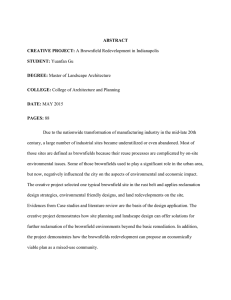
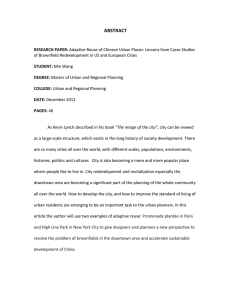
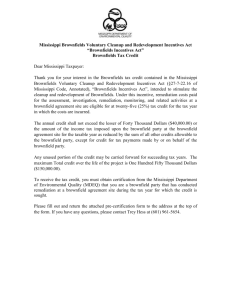
![Car Wash - Teachers [] - Carnegie Mellon University](http://s3.studylib.net/store/data/007759052_2-dc7f9f6e7ee8d5936ad1af830ebd5069-300x300.png)
